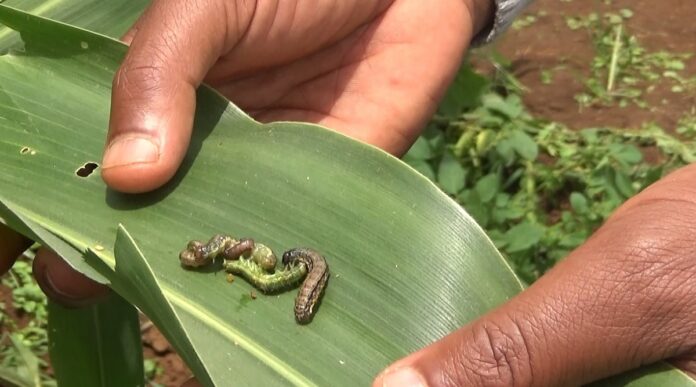The fall armyworm is native to South America and is established in parts of Mexico, the USA, and Central and South America. It was first reported in continental Africa by Sao Tome in 2013. It was later reported in Nigeria, Benin, and Togo, and later in Ghana. This was confirmed through molecular identification of samples collected as a result of reports received across the country in 2016. The pest has been reported in all ten (10) regions of Ghana.
In May 2017, Myjoyonline reported that the armyworms had invaded farms in the Ashanti, Brong Ahafo, and Eastern regions, spreading unchecked in Ghana. The Fall Armyworm was first noticed in Africa in January 2016. They caused massive damage to crops in several West African countries (International Institute of Tropical Agriculture, IITA – Benin).
How has Fall Armyworm affected your farms?
Read also: How to Control African Armyworm in Maize
What is the Fall Armyworm?
According to herald.co.zw, it can travel up to 2000km each year in search of warmer climates. Also, the worm is averse to the harsh winter of North America and so returns to its tropical habitat in the autumn, which the Americans call “fall,” hence the name “Fall Armyworm.”
What is the difference between the African Armyworm and the Fall Armyworm?
According to experts, the fall armyworm creates tiny holes in the stem of the maize plant. That is not the way of the African armyworm.
The African armyworm usually hatches somewhere outside the farms and then steadily eats its way through everything in its path as a group. In contrast, the fall armyworm moth lays its eggs on the host plant. It does not eat everything, and as it grows, it moves up the maize plant. By that stage, the worm would have destroyed most of its competitors.
The fall armyworm makes a lot of yellowish debris and whitish powder on the leaves and the funnel where they are. (herald.co.zw)
Recommended pesticides from PPRSD
The Plant Protection and Regulation Service Directorate (PPRSD) of the Ministry of Food and Agriculture (MOFA) in Ghana has, as a matter of urgency, released a list of recommended pesticides for Fall Armyworm control.
The table presents the recommended pesticides with their active ingredients, their rates of application and more. For a hectare, PPRSD recommends 8 times the application rate.
| No. | Active Ingredient | Brand Name | Application Rate |
| 1 | Maltodextrin | Eradicot T | 50ml/15lt water |
| 2 | Emamectin Benzoate+Acetamiprid | Ema Star 112EC | 20ml/15lt water |
| 3 | Emamectin Benzoate | Control 5WDG | 30g/15lt water |
|
|
| Ataka Super EC | 75ml/15lit water |
| 4 | Bacillus thuringiensis (Bt) | Bypel 1 | 15g (3cups) /15lt water |
|
|
| Agoo | 50g (1 sachet)/15lt water |
| 5 | Chlorpyrifos+Deltamethrin | Pyrinex Quick 256EC | 70ml/15lt water |
| 6 | Acetamiprid + Indoxacarb | Viper 46EC | 40ml/15lt water |
| 7 | Ethyl palmitate | Adepa | 100ml/15lit water |
| 8 | Lambda- cyhalothrin+Acetamiprid | Super top | 30ml/15lt water |
|
|
| K-Optimal EC | 50ml/15lt water |
| 9 | Imidacloprid + Betacyflutherine | Thunder 145 OD O-TEQ | 50ml/15lt water |
| 10 | Imidacloprid+Bifenthrin | Galil 300SC | 15ml/15lt water |
| 11 | Acetamiprid+Cypermethrin | Chemaprid | 100ml/15lt water |
Featured image source: www.ghananewsagency.org


